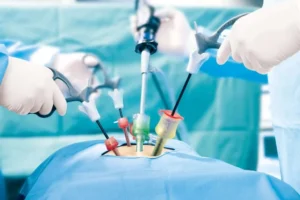Corn Removal Surgery: When Do You Need It?

It’s common to ignore foot health until discomfort arises. Corns are a common issue that can cause significant pain and discomfort if left untreated. While most corns can be managed with home remedies or non-invasive treatments, some cases may require surgical intervention. This is where corn removal surgery comes into play. This article will explore when you might need corn removal surgery, what the procedure involves, and how to care for your feet afterwards.
What is corn?
The corns are small, thickened skin areas resulting from constant stress or irritation. They usually form on the toes or the soles of the feet. Foot health is often overlooked until discomfort sets in. Corns are the body’s way of protecting the skin from excessive pressure, but they can become painful and inflamed over time.
There are three main types of corn:
- Hard corns: small, dense areas of skin usually found on the tops of toes or the sides of feet.
- Soft corns are wavy, rubbery areas of skin that often develop between the toes due to moisture and pressure.
- Seed corns: tiny corns that form on the soles of the feet.
While mild corns can be treated with proper footwear, padding, and skin care, severe or recurring corns may require corn removal surgery.
When Do You Need Corn Removal Surgery?
Not all corn needs surgical removal. However, you might need to consider corn removal surgery if:
1. Persistent Pain and Discomfort
If a corn causes ongoing pain and discomfort despite trying home remedies or over-the-counter treatments, surgery may be the best option. Persistent pain can interfere with daily activities like walking, exercising, or standing for long periods.
2. Recurrent Corns
If the corn keeps coming back even after treatment, there might be an underlying structural issue with the foot, such as a misaligned toe or abnormal bone structure. In such cases, corn excision can help prevent recurrence.
3. Infection or Inflammation
Infected corns can lead to redness, swelling, and pus formation. If the corn becomes infected, your doctor might recommend surgical removal to prevent the infection from spreading.
4. Difficulty Walking or Wearing Shoes
When a corn interferes with walking or makes it difficult to wear shoes comfortably, it can affect your overall mobility and quality of life. Corn removal surgery can help restore comfort and improve foot function.
What to Expect During Corn Removal Surgery
Corn removal surgery is a minor procedure that is typically performed under local anesthesia. It is a quick and straightforward process, and most patients can walk immediately after the procedure.
Step-by-Step Procedure:
- Preparation: The area around the corn is cleaned, and a local anesthetic is administered to numb the foot.
- Excision: The surgeon will carefully remove the hardened skin and the core of the corn using a scalpel. This process is known as corn excision.
- Correction (if needed): If the corn was caused by an underlying structural problem, the surgeon may correct the bone alignment to prevent recurrence.
- Closure and Dressing : After the excision, the area is cleaned and dressed with a sterile bandage. Stitches are usually not required unless there is deeper tissue involvement. The procedure takes 30 minutes.
After Corn Removal Care
Proper care after surgery is essential to ensure proper healing and prevent complications. Here’s what you need to know about after corn removal care:
1. Rest and Elevate Your Foot
Keep your foot elevated for the first 24 to 48 hours to reduce swelling and promote healing. Avoid putting too much weight on the treated area.
2. Keep the Area Clean and Dry
Follow your doctor’s instructions for cleaning the wound. Keep the bandage dry and avoid soaking your foot in water until the wound has healed.
3. Wear Comfortable Footwear
Choose shoes with a wide toe box and soft soles to reduce pressure on the treated area. Avoid tight shoes & heels.
4. Monitor for Signs of Infection
Watch for signs of infection such as redness, Infection signs included redness, swelling, warmth, & discharge.
5. Follow Up with Your Doctor
Attend all follow-up appointments to ensure that the wound is healing properly and that there are no complications.
Benefits of Corn Removal Surgery
Undergoing corn removal surgery can provide several benefits:
- Immediate relief from pain and discomfort
- Improved foot appearance and health
- Enhanced mobility and comfort in wearing shoes
- Reduced risk of recurrence if underlying issues are corrected
Risks and Complications
While corn removal surgery is generally safe, like any surgical procedure, it carries some risks:
- Infection: Proper postoperative care reduces this risk.
- Scarring: Mild scarring may occur but usually fades over time.
- Recurrence: If the underlying cause (such as misaligned toes) is not addressed, the corn may return.
- Nerve Damage: Rare but possible; consult your doctor if you experience numbness or tingling after surgery.
Preventing Corns After Surgery
To prevent corns from returning after surgery, follow these tips:
- Wear shoes that properly fit.
- Use cushioned insoles to reduce pressure on the feet.
- To Prevent soft corns, keep your feet dry and clean
- Moisturize your feet regularly to prevent dry, cracked skin.
- Avoid walking barefoot on hard surfaces.
Conclusion
Corn removal surgery is a safe and effective solution for painful, recurring, or infected corns. If you’ve tried non-surgical treatments without success, it may be time to consult a podiatrist about surgical options. The procedure is quick, with minimal recovery time, and can significantly improve your comfort and foot health.
With proper after-corn removal care and attention to foot health, you can prevent corns from returning and enjoy pain-free movement. If you’re considering corn removal surgery, consult with a foot specialist to determine the best treatment plan for your needs.
Frequently Asked Questions
Corn removal surgery is usually not very painful because it’s done under local anesthesia. Mild soreness or discomfort may occur afterward but is manageable with pain relievers.
Yes, corns can be removed permanently by addressing the underlying cause, such as friction or pressure, and using proper footwear and foot care.
The cost of corn removal surgery varies based on the clinic and the complexity of the procedure. Consulting a specialist can provide a more accurate estimate.
Recovery from corn surgery usually takes about 1 to 2 weeks. Full healing may take a few more weeks, depending on the procedure and foot care.
Corns may leave a small indentation or hole after removal. Proper care helps the skin heal smoothly over time.




















